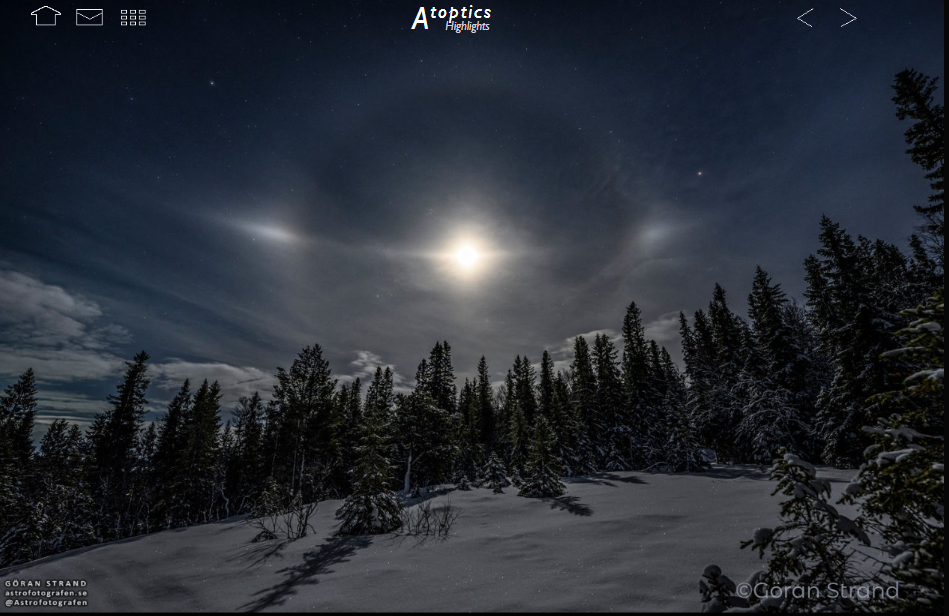Moon halos & Crystal Geometry, Sweden - Atoptics Highlights OPOD
Moon Halos & Crystal Geometry: A Fascinating Atmospheric Phenomenon
When gazing at the winter moon in Sweden, one may notice a mesmerizing sight - the moon surrounded by ethereal ice halos. Unlike the sun, which appears lower in the sky during the winter months, the moon rides high above Sweden, making it an ideal canvas for these captivating optical displays. In this article, we delve into the intricate world of moon halos and explore the precise crystal geometry behind their formation.
Halos, often appearing as if they were meticulously drawn on the sky with a compass and ruler, owe their precision to the exact geometry of ice crystals in the atmosphere. These crystals come in various shapes, including plate-like structures, elongated columns, and other intriguing forms. Despite their diversity, these ice crystals consistently exhibit a specific habit - a term used by crystallographers to describe the characteristic slope of their faces. It is this uniformity that allows moon and sun rays to refract and reflect between the unchanging planes of ice, ultimately sculpting halos onto the sky.
Unveiling the Components of a Moon Halo
When observing a moon halo, several distinct components may come into view, each contributing to the overall enchanting spectacle:
-
Diffused 22 Degree Halo: Encircling the moon, this halo is the most common and recognizable component. Its name derives from the angle it forms with respect to the observer's line of sight. The diffused nature of this halo results from light scattering within the ice crystals.
-
Paraselenic Circle: Crossing the 22-degree halo, this circular band adds an extra layer of intrigue to the phenomenon. It occurs when light rays refract through ice crystals at specific angles, creating a secondary halo around the moon.
-
Moondogs (Paraselenae): Positioned to the left and right of the moon, moondogs are bright spots that often accompany moon halos. These spots, also known as paraselenae, are caused by light passing through horizontally oriented ice crystals and refracting towards the observer.
Crystal Samples from the South Pole
To gain a deeper understanding of the ice crystals responsible for moon halos, researchers have collected samples during halo displays at various locations. Walter Tape, for instance, sampled crystals at the South Pole during such an event. These crystal samples offer valuable insights into the intricate structures that give rise to these optical phenomena.
Exploring Crystallography and Halo Formation
Crystallography plays a vital role in unraveling the mysteries behind moon halo formation. By studying the geometric properties of ice crystals, scientists can simulate how light interacts with these crystals and forms the intricate patterns seen in the sky. This field of study enables researchers to comprehend the specific angles at which light rays refract and reflect within the crystals, leading to the formation of halos with such remarkable precision.
Diverse Crystal Habits and Their Influence
Ice crystals exhibit a range of habits, each with its own unique characteristics. These habits determine the angles at which the crystal faces slope, ultimately influencing the appearance of halos. From hexagonal plates to columns with prismatic or pyramidal ends, the variety in crystal habits adds complexity and diversity to the shapes and patterns observed in moon halos.
A Harmonious Symphony of Light and Ice
The phenomenon of moon halos exemplifies the intricate dance between light and ice in Earth's atmosphere. As light interacts with ice crystals, it undergoes refraction, reflection, and scattering, resulting in a mesmerizing display of celestial artistry. Moon halos serve as a reminder of the harmonious symphony that occurs above us, showcasing the beauty and complexity of our natural world.
In conclusion, moon halos, with their precise geometry and captivating appearance, offer a glimpse into the fascinating world of atmospheric optics. By understanding the crystallography behind these phenomena, we gain a deeper appreciation for the interplay between light and ice in shaping the celestial wonders that grace our skies. So, the next time you find yourself gazing at the winter moon, take a moment to marvel at the ethereal beauty of moon halos and the intricate crystal geometry that brings them to life.

The winter moon, unlike the sun, rides high over Sweden. Ice halos surround it in this scene captured by Goran Strand.
Halos appear almost scribed on the sky with compass and ruler. Their precision follows from the exact geometry of the sky's ice crystals. Some are plate-like, some are long columns, others are stranger. Whatever their shape, habit is the precise crystallographer's term., their faces always slope at the same angles. Moon and sun rays refract and reflect between these never changing planes of ice to chisel halos onto the sky.
Top: A diffused 22 degree halo circles the moon. A paraselenic circle crosses it. Moondogs, paraselenae, bark to its left and right.
Below: Crystals sampled during a halo display at the South Pole by Walter Tape

Note: this article has been automatically converted from the old site and may not appear as intended. You can find the original article here.
Reference Atmospheric Optics
If you use any of the definitions, information, or data presented on Atmospheric Optics, please copy the link or reference below to properly credit us as the reference source. Thank you!
-
<a href="https://atoptics.co.uk/blog/moon-halos-crystal-geometry-sweden-atoptics-highlights-opod/">Moon halos & Crystal Geometry, Sweden - Atoptics Highlights OPOD</a>
-
"Moon halos & Crystal Geometry, Sweden - Atoptics Highlights OPOD". Atmospheric Optics. Accessed on November 26, 2024. https://atoptics.co.uk/blog/moon-halos-crystal-geometry-sweden-atoptics-highlights-opod/.
-
"Moon halos & Crystal Geometry, Sweden - Atoptics Highlights OPOD". Atmospheric Optics, https://atoptics.co.uk/blog/moon-halos-crystal-geometry-sweden-atoptics-highlights-opod/. Accessed 26 November, 2024
-
Moon halos & Crystal Geometry, Sweden - Atoptics Highlights OPOD. Atmospheric Optics. Retrieved from https://atoptics.co.uk/blog/moon-halos-crystal-geometry-sweden-atoptics-highlights-opod/.